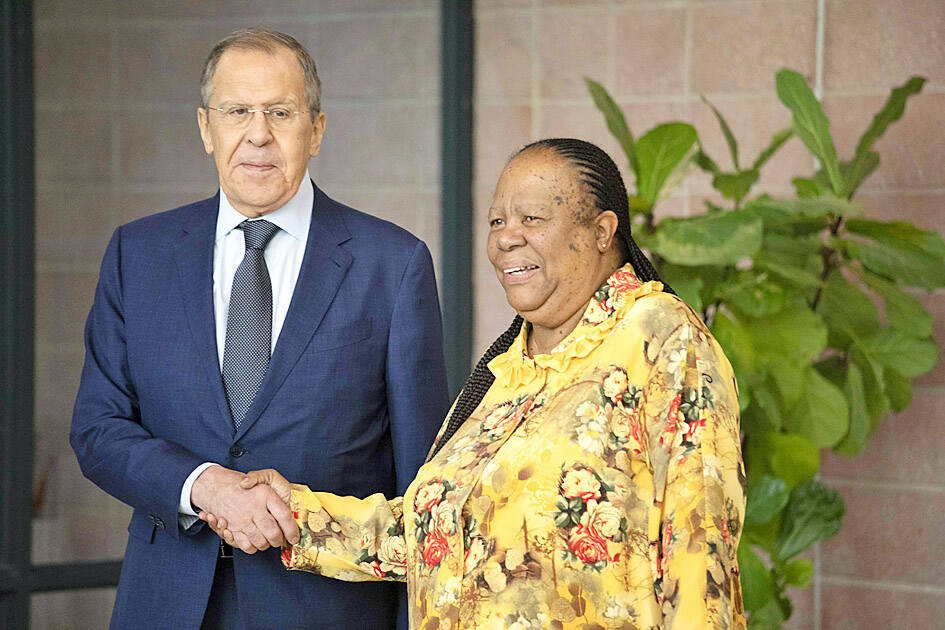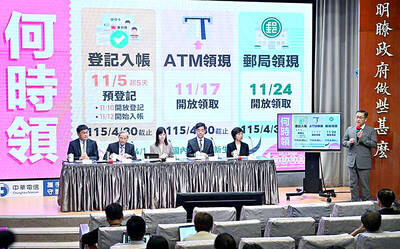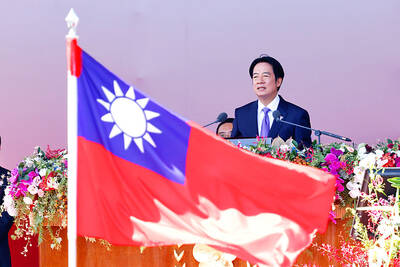A Russian warship armed with new-generation hypersonic cruise weapons is to participate in joint exercises with the navies of China and South Africa next month, the Russian news agency TASS said yesterday.
It was the first official mention of the participation by the frigate, Admiral of the Fleet of the Soviet Union Gorshkov, which is armed with Zircon missiles.
The missiles fly at nine times the speed of sound, with a range of more than 1,000km, Russia says.

Photo: EPA-EFE
They form the centerpiece of its hypersonic arsenal, along with the Avangard glide vehicle that entered combat duty in 2019.
“Admiral Gorshkov ... will go to the logistic support point in Syria’s Tartus, and then take part in joint naval exercises with the Chinese and South African navies,” the agency said, citing an unidentified defense source.
On Thursday, the South African National Defence Force said the drills, to run from Feb. 17 to 27 near the port city of Durban and Richards Bay, aim “to strengthen the already flourishing relations between South Africa, Russia and China.”
The exercise would be the second involving the three countries in South Africa, after a drill in 2019, the defense force added in its statement.
The Gorshkov this month held exercises in the Norwegian Sea after Russian President Vladimir Putin sent it to the Atlantic Ocean in a signal to the West that Moscow would not back down over the war in Ukraine.
Russia sees the weapons as a way to pierce increasingly sophisticated US missile defenses that Putin has warned could one day shoot down its nuclear missiles.
China, Russia and the US are in a race to develop hypersonic weapons, seen as a way to gain an edge over any adversary because of their speeds, greater than five times that of sound, and because they are harder to detect.
Meanwhile, South Africa defended the drills amid criticism over its noncommital stance on the war in Ukraine.
The South African Ministry of Defence and Military Veterans said it has conducted similar military maneuvers with the US, the UK and France without attracting “hype.”
“South Africa, like any independent and sovereign state, has a right to conduct its foreign relations in line with its own diplomatic relations and national interests,” the ministry said in a statement.
The exercise is aimed at “further strengthening the strong bonds that exist between South Africa, Russia and China,” it said.
The furor about the exercises comes as Russian Minister of Foreign Affairs Sergei Lavrov yesterday arrived to hold talks with his South African counterpart, while US Secretary of the Treasury Janet Yellen is due to arrive today.
South Africa has abstained on a number of UN resolutions condemning Russia’s invasion of Ukraine. Key government officials have made comments that have stoked criticism of the government’s approach to the conflict at a time when the Western nations opposing Russia’s action are among its main trading partners.
“Contrary to the assertions by our critics, South Africa is not abandoning its neutral position on the Russian-Ukraine conflict,” the ministry said. “We remain firm in our view that multilateralism and dialogue are keys to unlock sustainable international peace.”
While South Africa’s ruling African National Congress has historic ties to Russia, which supported the fight against apartheid, there are few economic links between the two nations.

People can preregister to receive their NT$10,000 (US$325) cash distributed from the central government on Nov. 5 after President William Lai (賴清德) yesterday signed the Special Budget for Strengthening Economic, Social and National Security Resilience, the Executive Yuan told a news conference last night. The special budget, passed by the Legislative Yuan on Friday last week with a cash handout budget of NT$236 billion, was officially submitted to the Executive Yuan and the Presidential Office yesterday afternoon. People can register through the official Web site at https://10000.gov.tw to have the funds deposited into their bank accounts, withdraw the funds at automated teller

PEACE AND STABILITY: Maintaining the cross-strait ‘status quo’ has long been the government’s position, the Ministry of Foreign Affairs said Taiwan is committed to maintaining the cross-strait “status quo” and seeks no escalation of tensions, the Ministry of Foreign Affairs (MOFA) said yesterday, rebutting a Time magazine opinion piece that described President William Lai (賴清德) as a “reckless leader.” The article, titled “The US Must Beware of Taiwan’s Reckless Leader,” was written by Lyle Goldstein, director of the Asia Program at the Washington-based Defense Priorities think tank. Goldstein wrote that Taiwan is “the world’s most dangerous flashpoint” amid ongoing conflicts in the Middle East and Russia’s invasion of Ukraine. He said that the situation in the Taiwan Strait has become less stable

CONCESSION: A Shin Kong official said that the firm was ‘willing to contribute’ to the nation, as the move would enable Nvidia Crop to build its headquarters in Taiwan Shin Kong Life Insurance Co (新光人壽) yesterday said it would relinquish land-use rights, or known as surface rights, for two plots in Taipei’s Beitou District (北投), paving the way for Nvidia Corp to expand its office footprint in Taiwan. The insurer said it made the decision “in the interest of the nation’s greater good” and would not seek compensation from taxpayers for potential future losses, calling the move a gesture to resolve a months-long impasse among the insurer, the Taipei City Government and the US chip giant. “The decision was made on the condition that the Taipei City Government reimburses the related

FRESH LOOK: A committee would gather expert and public input on the themes and visual motifs that would appear on the notes, the central bank governor said The central bank has launched a comprehensive redesign of New Taiwan dollar banknotes to enhance anti-counterfeiting measures, improve accessibility and align the bills with global sustainability standards, Governor Yang Chin-long (楊金龍) told a meeting of the legislature’s Finance Committee yesterday. The overhaul would affect all five denominations — NT$100, NT$200, NT$500, NT$1,000 and NT$2,000 notes — but not coins, Yang said. It would be the first major update to the banknotes in 24 years, as the current series, introduced in 2001, has remained in circulation amid rapid advances in printing technology and security standards. “Updating the notes is essential to safeguard the integrity